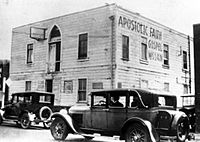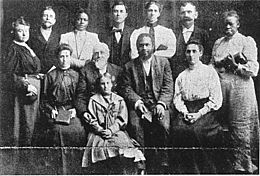William J. Seymour facts for kids
Quick facts for kids
William Joseph Seymour
|
|
|---|---|

Leader of the Azusa Street Revival William J. Seymour
|
|
| Born | May 2, 1870 Centerville, Louisiana, United States
|
| Died | September 28, 1922 (aged 52) Los Angeles, California, United States
|
| Occupation | Evangelist |
| Spouse(s) | Jenny Evans Moore, 1906–1922, (his death) |
William Joseph Seymour (born May 2, 1870 – died September 28, 1922) was an African-American preacher. He started the Azusa Street Revival, a very important event in the history of Pentecostal and Charismatic Christian groups.
Seymour was born in Louisiana to parents who had been freed from slavery. His family was very poor. He studied with an early Pentecostal minister named Charles Parham. Seymour believed that speaking in tongues was a special sign. It showed that someone had received the baptism in the Holy Spirit.
In 1906, Seymour moved to Los Angeles, California. There, he shared his Pentecostal message. This led to the start of the Azusa Street Revival. Many people came to the revival. News reporters also covered it. They focused on the unusual religious practices. They also noted the worship services where people of different races prayed together. This was very uncommon at the time.
Seymour became well-known in the new Pentecostal movement. He led the revival and published The Apostolic Faith newspaper. Later, Seymour and Parham had disagreements. This included Parham not liking the mixed-race meetings. The revival's influence grew beyond Los Angeles. Seymour tried to create a larger group called the Apostolic Faith Movement. However, other ministers caused problems. This hurt the unity of the early Pentecostal movement. It also made Seymour's influence decrease. By 1914, the revival was not as big as before. But Seymour continued to lead the Apostolic Faith Mission until he died. The revival helped spread Pentecostal practices worldwide. These included speaking in tongues and integrated worship. It was also important for most major Pentecostal churches.
Contents
William Seymour's Early Life
William Joseph Seymour was the second of eight children. His parents, Simon and Phyllis Salabar Seymour, were formerly enslaved people. He was born in Centerville, Louisiana. As a child, he was baptized in a Catholic parish.
When William was 14, his parents built a house. It was near the New Providence Baptist Church. His family likely attended this church. William's father died in 1891. William, then 21, became the main provider for his family. They grew crops to feed themselves. They had very little other money. The family kept their home but lived in poverty.
Seymour grew up during a time of strong racism. This likely led him to move north. He wanted to escape the unfair treatment of Black people in the South. In 1895, Seymour moved to Indianapolis. There, he became a born-again Christian.
Starting His Ministry
In Indianapolis, Seymour learned about the Holiness movement. He joined a group called the "Evening Light Saints." This group believed in things like faith healing. They also believed in foot washing. They thought Jesus would return soon. They also wanted to live separately from "the world." This meant not wearing jewelry or neckties.
In 1901, Seymour moved to Cincinnati. He worked as a waiter there. He probably attended God's Bible School and Training Home. This school was started by a holiness preacher. Black and white students studied together at this school. While in Cincinnati, Seymour got smallpox. He lost sight in his left eye. Seymour felt this happened because he had not answered God's call to become a minister.
Seymour moved to Houston in 1903. He met other holiness leaders there. One of them was Charles Parham. Parham was leading a growing movement.
Learning About Speaking in Tongues
Parham's Apostolic Faith Movement focused on speaking in tongues. Parham believed speaking in tongues was a sign. It showed that a Christian had received the baptism with the Holy Spirit. On January 1, 1901, Parham and his students prayed for Agnes Ozman. She then began to speak in what sounded like Chinese. She had never learned Chinese. Many Pentecostals believe Ozman was the first person in modern times to speak in tongues this way.
Parham also spoke in tongues. He opened a Bible school in Houston in 1905. Lucy Farrow, a Black holiness leader, worked for Parham. She asked Seymour to lead her church. In 1906, Seymour joined Parham's new Bible school. Texas had Jim Crow laws at the time. These laws separated Black and white people. Seymour sat just outside the classroom door. Parham allowed him to preach only to Black people.
Seymour prayed to receive the baptism with the Holy Spirit. He believed in speaking in tongues. But he did not agree with Parham on everything. Parham thought tongues were for speaking unlearned human languages. He believed they were for spreading the Christian message.
After studying with Parham for a month, Seymour got an invitation. He was asked to lead a holiness mission in Los Angeles. Julia Hutchins started this mission. Parham thought Seymour was not ready. He had not yet been baptized in the Holy Spirit. But Seymour went to Los Angeles anyway.
The Azusa Street Revival Begins
Seymour arrived in Los Angeles on February 22, 1906. Two days later, he preached at Julia Hutchins's church. Seymour taught that speaking in tongues was proof of receiving the Holy Spirit. But he had not experienced it himself. Hutchins and other holiness leaders disagreed. They locked the church doors to keep Seymour out.
The holiness leaders held a meeting. They asked Seymour about his beliefs. They said that being "sanctified" and receiving the Holy Spirit were the same thing. Seymour was not convinced they had received the Spirit's baptism. The leaders removed him from his pastor role. They told him not to teach his ideas in their church. But they also said they were interested in his experience.
The First Experiences with Tongues
Seymour stayed at a friend's house, Edward Lee's. He started a prayer meeting there. When too many people came, it moved to Richard Asberry's home. (One person who attended, Jennie Evans Moore, later married Seymour.) The group accepted Seymour's teaching. They prayed to receive the Holy Spirit's baptism.
Seymour invited two friends from Houston to help him. They were Lucy Farrow and Joseph Warren. The main group had about 15 African Americans, including five children. Others joined them, like Frank Bartleman. He later wrote a detailed book about the Azusa Street Revival. The meetings at the Asberry's house grew bigger. News spread about the new teachings.
On April 6, 1906, the group decided to add fasting to their prayers. They planned to fast for ten days. During this time, they would study Acts 2:1–4. They would pray every evening. They wanted to have the same experience described in the Bible.
On April 9, Edward Lee spoke in tongues. This happened after Seymour and Lucy Farrow prayed for him. The group was overjoyed. They walked to the Asberry's house for the evening meeting. Seymour spoke about what had just happened to Edward Lee. Soon, someone else began to speak in tongues. Before the night ended, several others did too. This included Jennie Evans Moore. Over the next three days, the Asberry home became a center of attention. News spread quickly. The Azusa Street Revival had begun.
Moving to Azusa Street
Three days later, on April 12, Seymour himself received the Holy Spirit's baptism. He also spoke in tongues. By then, the group was too big for the Asberry's house. The front porch even collapsed from the weight of the crowd! Seymour had to find a new place.
The group moved to an old church building. It was at 312 Azusa Street in Los Angeles. It was officially called the Apostolic Faith Mission. But it became known as the Azusa Street Mission.
The revival quickly grew. Up to 1,500 people packed into the small mission. This happened for almost three years. At its busiest, meetings ran from morning until midnight. They met seven days a week. Many well-known early Pentecostal leaders visited the revival. They then took what they learned to other places.
A Place for Everyone
From the start, the movement treated everyone equally. Black and white people worshipped together. This was against the normal separation of races at that time. Seymour said the Holy Spirit was bringing people together. He believed it broke down all social barriers. He also allowed women to be church leaders. This was also very unusual then. Soon, Latino people also joined. A Mexican-American worker received the Holy Spirit baptism on April 13, 1906.
Seymour was clearly the leader of the Azusa revival. He gave authority to twelve overseers. He also ordained ministers and sent out missionaries. In September 1906, he started publishing a newspaper. It was called The Apostolic Faith. Within one year, 40,000 copies of his paper were printed. Many important holiness preachers visited Azusa. They preached and prayed with Seymour.
The movement became known as Pentecostalism. This name came from the Bible. It refers to the day of Pentecost in the book of Acts. By the end of 1909, the movement was everywhere. Every part of the United States had a Pentecostal presence. Missions were also started in 50 other countries.
Later Years and Legacy
The revival at Azusa continued to grow until 1908. But then, other evangelists began to disagree with Seymour. This included Florence Crawford, who had worked with Seymour. They caused problems for the movement.
Even though his message had spread worldwide, Seymour's church on Azusa Street became smaller by 1914. It became a small, local Black American church. He continued to be the pastor until he died. On September 28, 1922, Seymour had two heart attacks. He died in his wife's arms. He was buried in Evergreen Cemetery in East Los Angeles. Jennie Seymour died on July 2, 1936. She was buried next to her husband.
William Seymour's Influence
Under Seymour's leadership, the Azusa Street Mission sent out evangelists. They spread the Pentecostal message across the United States. Many new missions were started. They copied the Azusa mission. By 1914, Pentecostalism was in almost every major U.S. city. All major American Pentecostal churches can trace their beginnings to Azusa Street. This includes the Assemblies of God and the Church of God in Christ.
The mission's teachings quickly went around the world. Many missionaries who spread the message had been at the Azusa Street revival. By 1907, missionaries from Azusa Street had reached Mexico, Canada, Europe, the Middle East, West Africa, and parts of Asia. Today, hundreds of millions of people around the world are Pentecostals.
|
See also
 In Spanish: William J. Seymour para niños
In Spanish: William J. Seymour para niños





